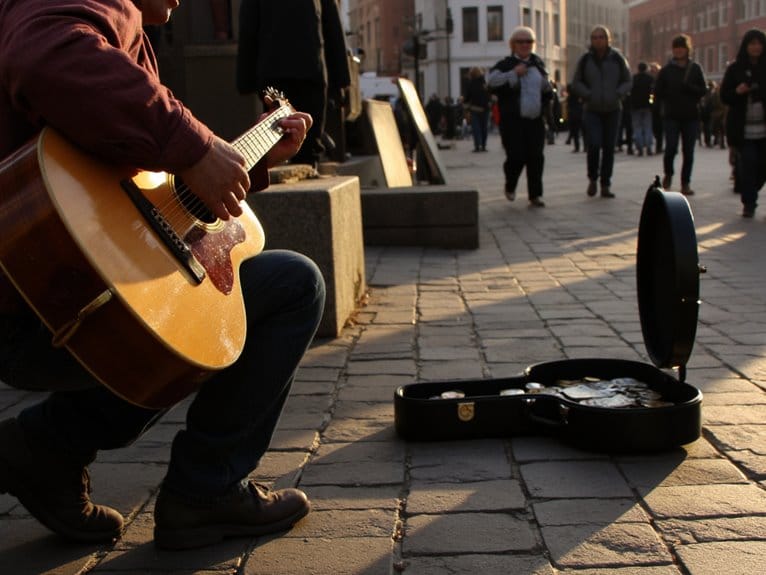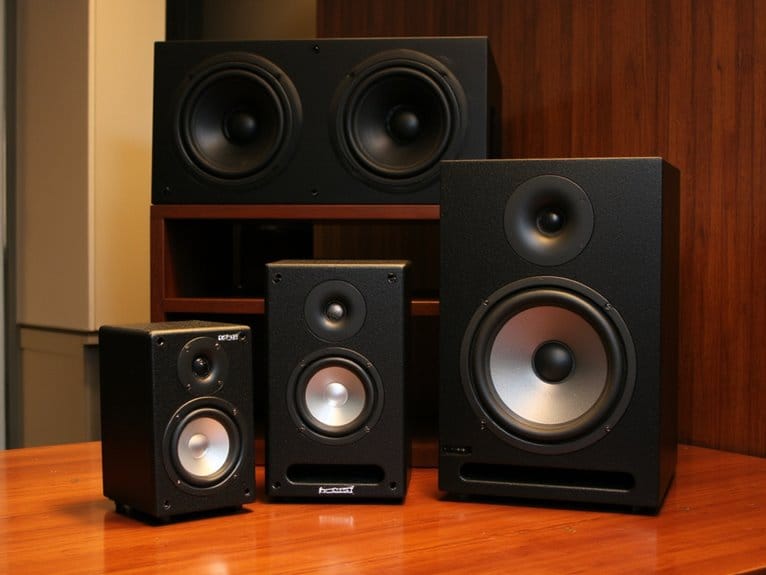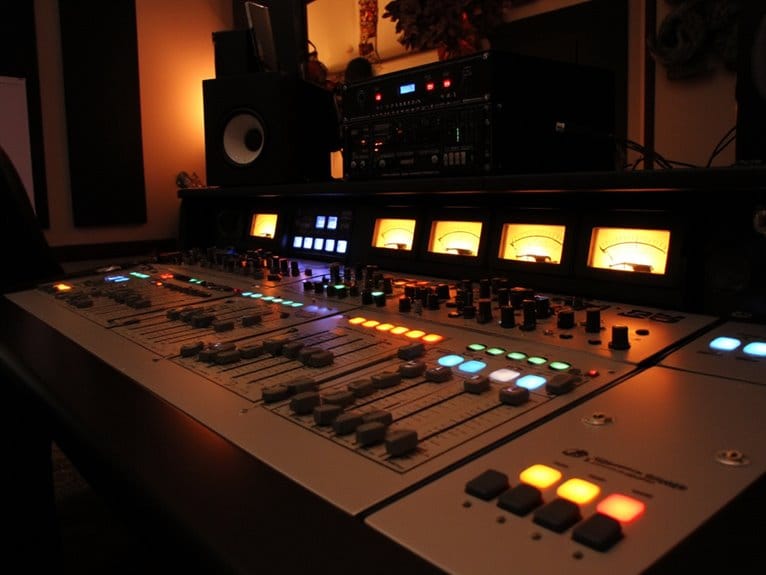Street Music: The Art of Performing in Public Spaces
Street music transforms public spaces into cultural venues where you’ll discover performers earning an average of $21.56 hourly, with top artists making over $140,000 annually through diversified income streams including merchandise and corporate gigs. You’ll need to navigate city-specific permit requirements, as regulations vary considerably between locations like Chicago, which requires permits, and San Antonio, which doesn’t. These performances create community connections by turning hurried commuters into engaged audiences, fostering social cohesion through music’s universal language while activating underutilized spaces for cross-cultural interaction and relationship building, though there’s much more beneath this vibrant artistic landscape.
We are supported by our audience. When you purchase through links on our site, we may earn an affiliate commission, at no extra cost for you. Learn more.
Notable Insights
- Street music evolved from Roman festivals and medieval marketplaces, with minstrels serving as early cultural messengers in public spaces.
- Professional buskers can earn substantial income, with top performers making over $140,000 annually through diverse revenue streams.
- Legal requirements vary by city, with some requiring permits while First Amendment protections generally cover public performances.
- Street performances transform strangers into engaged participants, strengthening social cohesion through shared musical experiences in communities.
- Public music activates underutilized spaces, enhances safety, and creates opportunities for spontaneous cross-cultural connections among diverse audiences.
The Cultural Heritage and Evolution of Busking
Few cultural traditions can claim as rich and enduring a legacy as busking, which I’ve traced back through centuries of human civilization to its ancient roots in Roman festivals and medieval marketplaces.
You’ll find the cultural significance of street performance runs deeper than most realize, evolving from lyrical contests and court jesters who balanced entertainment with pointed social commentary.
I’ve observed how historical trends shaped busking’s trajectory, from medieval minstrels serving towns and marketplaces to Renaissance performers who transformed urban plazas into vibrant cultural hubs. The growth of urban centers during this period created unprecedented opportunities for performers to reach larger and more diverse audiences.
What’s fascinating is how these early street artists didn’t just entertain—they disseminated news, stories, and cultural expressions across diverse social groups, creating the foundation for today’s public performance traditions. In early America, buskers often performed alongside medicine shows, promoting dubious remedies while showcasing their musical talents to captivated crowds.
Economic Benefits and Career Opportunities for Independent Artists
While this rich cultural heritage laid the foundation for modern street performance, today’s independent artists have discovered that busking offers surprisingly robust economic opportunities that extend far beyond the traditional hat-on-the-ground model.
You’ll find that average hourly earnings reach $21.56 nationally, with top performers in cities like San Jose commanding up to $142,373 annually.
Smart income diversification through merchandise sales, corporate gigs, and online platforms creates multiple revenue streams that offset street performance’s inherent unpredictability.
Diversified revenue streams through merchandise, corporate performances, and digital platforms provide financial stability beyond unpredictable street earnings.
Effective performance marketing opens doors to club residencies, festival bookings, and recording contracts, transforming street corners into launching pads for sustainable music careers. Street musicians must maintain detailed records of all earnings since income is classified as self-employment and subject to federal taxation requirements.
Geographic location notably impacts earnings potential, making strategic venue selection essential for maximizing your artistic investment. The salary distribution reveals that 26% of street musicians earn between $35,500 and $43,499 annually, demonstrating consistent middle-income potential for dedicated performers.
Legal Considerations and Permit Requirements
Before you set up your guitar case and start strumming, you’ll need to navigate the complex web of legal requirements that govern street performance, which varies dramatically from city to city and can make the difference between a profitable day and an expensive citation.
Understanding permit regulations becomes essential since cities like Chicago demand permits for every performance, while San Antonio requires none. Your legal protections stem from First Amendment rights, which courts consistently uphold as long as you comply with time, place, and manner restrictions.
Beyond permits, many cities enforce noise limits and designated performance hours that can restrict when and how loudly you can perform. In New York City, non-amplified busking requires no permit, but amplified performances need a $45 daily permit.
| City | Permit Required | Special Requirements |
|---|---|---|
| Chicago | Yes | All performances |
| Austin | Parks only | $10 daily fee |
| San Antonio | No | Follow solicitation rules |
| London Underground | Yes | Annual auditions |
| Boston | Varies | Liability insurance |
Smart performers research local ordinances thoroughly before performing.
Building Community Connections Through Public Performance
When you plant yourself on a busy corner with your instrument, you’re not just performing music—you’re weaving threads that connect strangers, neighbors, and entire communities in ways that few other art forms can achieve.
Street music transforms corners into stages where melodies bridge the gaps between strangers and build unexpected community connections.
Street performances transform ordinary public spaces into vibrant social hubs where diverse audiences gather, creating shared experiences that transcend cultural and demographic boundaries.
Through music participation, you’ll notice how passersby evolve from hurried commuters into engaged listeners who smile, clap, and sometimes dance alongside your melodies.
This community engagement strengthens social cohesion as your performances give neighbors reasons to pause, interact, and discover common ground through collective appreciation of live music. Street music serves as a universal language that breaks down barriers between people who might otherwise never interact. Research shows that engaged audience members develop higher levels of satisfaction and demonstrate their appreciation through donation behavior. Modern street musicians often rely on portable amplification to ensure their performance reaches audiences across busy urban environments. With wireless microphones offering impressive ranges up to 200 feet, performers can move freely while maintaining clear audio quality that connects with their audience.
- Activate underutilized public spaces, making them safer and more welcoming
- Foster cross-cultural connections among diverse community members
- Create opportunities for spontaneous social interaction and relationship building
- Encourage repeat engagement that builds loyal, supportive local audiences
- Develop shared identity through regular community music experiences
On a final note
You’ve discovered that street music isn’t just entertainment—it’s a legitimate artistic pathway that connects communities, builds careers, and preserves cultural traditions. Whether you’re considering picking up your guitar for your first sidewalk performance or you’re already managing permit requirements, remember that busking offers unique opportunities to develop your craft while earning income. Your public performances contribute to vibrant urban culture and authentic human connections.






